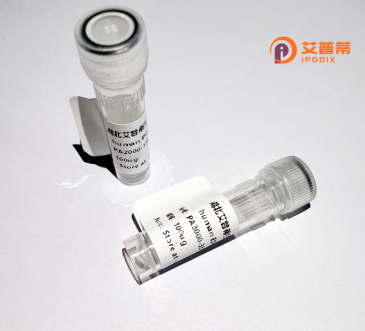
| 纯度 | >90%SDS-PAGE. |
| 种属 | Human |
| 靶点 | TBR1 |
| Uniprot No | Q16650 |
| 内毒素 | < 0.01EU/μg |
| 表达宿主 | E.coli |
| 表达区间 | 1-682 aa |
| 活性数据 | MQLEHCLSPS IMLSKKFLNV SSSYPHSGGS ELVLHDHPII STTDNLERSS PLKKITRGMT NQSDTDNFPD SKDSPGDVQR SKLSPVLDGV SELRHSFDGS AADRYLLSQS SQPQSAATAP SAMFPYPGQH GPAHPAFSIG SPSRYMAHHP VITNGAYNSL LSNSSPQGYP TAGYPYPQQY GHSYQGAPFY QFSSTQPGLV PGKAQVYLCN RPLWLKFHRH QTEMIITKQG RRMFPFLSFN ISGLDPTAHY NIFVDVILAD PNHWRFQGGK WVPCGKADTN VQGNRVYMHP DSPNTGAHWM RQEISFGKLK LTNNKGASNN NGQMVVLQSL HKYQPRLHVV EVNEDGTEDT SQPGRVQTFT FPETQFIAVT AYQNTDITQL KIDHNPFAKG FRDNYDTIYT GCDMDRLTPS PNDSPRSQIV PGARYAMAGS FLQDQFVSNY AKARFHPGAG AGPGPGTDRS VPHTNGLLSP QQAEDPGAPS PQRWFVTPAN NRLDFAASAY DTATDFAGNA ATLLSYAAAG VKALPLQAAG CTGRPLGYYA DPSGWGARSP PQYCGTKSGS VLPCWPNSAA AAARMAGANP YLGEEAEGLA AERSPLPPGA AEDAKPKDLS DSSWIETPSS IKSIDSSDSG IYEQAKRRRI SPADTPVSES SSPLKSEVLA QRDCEKNCAK DISGYYGFYS HS |
| 分子量 | 74.0 kDa |
| 蛋白标签 | His tag N-Terminus |
| 缓冲液 | PBS, pH7.4, containing 0.01% SKL, 1mM DTT, 5% Trehalose and Proclin300. |
| 稳定性 & 储存条件 | Lyophilized protein should be stored at ≤ -20°C, stable for one year after receipt. Reconstituted protein solution can be stored at 2-8°C for 2-7 days. Aliquots of reconstituted samples are stable at ≤ -20°C for 3 months. |
| 复溶 | Always centrifuge tubes before opening.Do not mix by vortex or pipetting. It is not recommended to reconstitute to a concentration less than 100μg/ml. Dissolve the lyophilized protein in distilled water. Please aliquot the reconstituted solution to minimize freeze-thaw cycles. |
以下是关于重组人TBR1蛋白的3篇参考文献的简要总结:
---
1. **文献名称**:**Tbr1 regulates differentiation of the preplate and layer 6**
**作者**:Hevner, R.F., et al. (2001)
**摘要**:该研究首次在小鼠模型中揭示了TBR1作为转录因子在早期皮层发育中的关键作用,调控前板神经元的分化及第6层皮质神经元的形成,对突触连接和大脑回路建立至关重要。
---
2. **文献名称**:**The role of Tbr1 in cortical development and autism spectrum disorders**
**作者**:O'Roak, B.J., et al. (2012)
**摘要**:本文通过基因测序发现TBR1突变与自闭症谱系障碍(ASD)显著相关,功能实验表明突变损害TBR1的DNA结合能力,导致下游靶基因(如RELN)表达异常,从而影响神经元迁移和突触可塑性。
---
3. **文献名称**:**TBR1 interacts with POU-domain factors to direct postmitotic neuronal cell fate**
**作者**:Notwell, J.H., et al. (2016)
**摘要**:研究通过重组TBR1蛋白的生化分析,揭示了其与POU3F2等转录因子形成复合物的机制,协调皮质神经元分化的分子通路,为神经发育疾病的机制提供了新见解。
---
这些文献涵盖了TBR1在神经发育中的分子功能及病理意义,从基础机制到疾病关联均有涉及。如需具体研究重组表达方法,建议补充关键词“recombinant expression”进一步筛选。
T-box brain 1 (TBR1) is a transcription factor critical for cortical brain development. Belonging to the T-box gene family, it contains a conserved DNA-binding T-domain that regulates target gene expression. TBR1 is predominantly expressed in postmitotic neurons during embryogenesis, playing a key role in the differentiation and laminar organization of the neocortex, particularly in layer VI and the subplate. It governs the identity of glutamatergic neurons and establishes cortical connectivity by regulating genes like *Fezf2* and *Bcl11b*.
First identified in mice, human TBR1 shares high homology and functional conservation. Mutations in the *TBR1* gene are linked to neurodevelopmental disorders, including autism spectrum disorder (ASD), intellectual disability, and epilepsy. These pathogenic variants often disrupt DNA binding or protein interactions, altering neuronal migration and synaptic function.
Recombinant human TBR1 protein, produced via bacterial or eukaryotic expression systems, enables structural and functional studies. It is widely used to investigate DNA-binding mechanisms, protein-protein interactions (e.g., with CASK or FOXP2), and transcriptional regulatory networks in vitro. Such research aids in deciphering TBR1's role in neurodevelopment and its potential as a therapeutic target. Studies also leverage TBR1 recombinant protein to model disease-associated mutations, offering insights into their pathological impacts on neural circuitry.
×